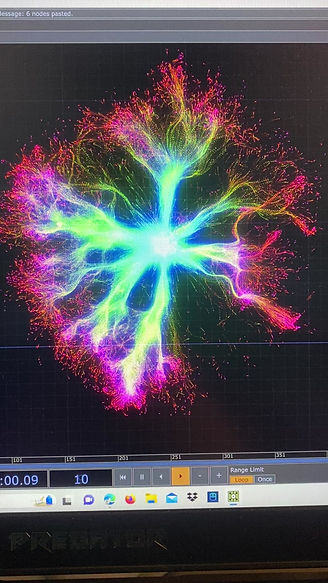
Exploring the future of wearable technology, how might our interactions with the world be transformed?
Details
Timeline: 14 weeks
Role: Experience Designer, Prototyper
Team: Thomas Youn, Cora Zhu, Sheryl Long, Harry He
Tools: Unity, Blender, C#, C++, TouchDesigner, Arduino
Contributions
Hardware. Led device prototyping, assessing potential for enhancing human abilities whilst ensuring a comfortable fit for diverse body shapes.
Experience. Designed audio-reactive visuals with TouchDesigner, immersing users in the fictional setting and wrote onboarding/off boarding scripts to convey their role's significance.
Achievements
Presentation. Showcased a unique location-based entertainment experience to over 80 guests.
User Experience. Guests felt like they were augmented with special abilities in reality.
Design Learning. Designing interactions for wearables and dealing with the challenges of integrating technology onto the human body.
THE GOAL
Use wearable technology and computer vision as bodily augmentations to make people feel superhuman.

Prototyping
What interactions could I design that evoked a sense of advanced abilities in 4 weeks?
Whisker
If sight is hindered, users with this wearable can navigate spaces using audio feedback.

Build

Ulrasonic Sensor (Input)
Piezo Buzzer (output)
Wear

Test
Demo
Discoveries
Sensory Deprivation issues. Losing a sense is disorienting; relying on the device for navigation felt challenging and I didn't feel augmented.
Adaptation Time. Festival experiences needed to be short. Users would likely take too long to adapt to losing a sense for enhancing another.
Thermal Vision
We can only sense and perceive heat via touch. Building a heads-up display to see heat created interesting possibilities for interaction.

Program

Experiment

Wear


Test
Discoveries
Temperature Regulation. Interaction Design for this prototype proved challenging because of uncontrollable central heating in the building.
Visual Strain. The low resolution of the small display meant that users had to strain their eyes to focus on the screen.
Professional Products

Arduino Prototypes
OR

Professional Products
DECISION: Professional Products
Durability and guest comfort during wearable usage was important. I wanted as many people as possible to complete our experience without disruptions.
Given this, I chose professional products over Arduino prototypes because they could be smoothly applied to the body.
User Testing
Hardware resilience/versatility. Could the hardware be robust and comfortable to ensure the best experience for as many guests as possible?
Body types. Test on all shapes and sizes, especially the sleeve as this was the main wearable input.

Discoveries
Improve sleeve versatility. The sleeve sensor pad required precise positioning and adjustments based on arm size. Guests with larger hands faced difficulty putting on the sleeve. Subsequently, we opted to cut the sleeve and attach a Velcro strap for quick, convenient adjustments.
Kinect hand tracking inaccuracy. The Kinect occasionally detected faces or lost hand tracking if the room was too light; a dark backdrop would be needed for the best tracking accuracy.
Physical discomfort. User's shoulders began to ache from extending their arm for long periods of time. The experience would need to be even shorter and more linear to prevent this from happening.

Experience Design
Ambitious Scope. With the prototyping phase complete, my focus shifted to designing a captivating, immersive experience with intriguing interactions.
Focused experience. Opting for a single-player approach minimized system complexity and the risk of errors, allowing us to concentrate on perfecting the desired experience for one person at a time.

Neurosage
Impact. This character introduces the user to the experience, delivering onboarding information in a striking and memorable manner.
Design Inspiration. Inspired by neurons and interstellar nebulas, I aimed to craft a powerful and awe-inspiring experience for the guest.
Sentient Form. To make it seem alive, I utilised TouchDesigner's audio reactive capabilities.

1
Creating the sense of a free flowing, dynamic form

2
Adding colour and refining the neuron shape

3
Experimenting with glow for audio reactive effect
4
A dynamic particle system that adapts to audio input

Main viewport
Side displays showing additional information.
The Room
Collaborative Effort. Worked as a team to build and design the room.
Simple Materials. Constructed with black painted cardboard and foam board.
Immersive Setting. Guests would feel like they are surrounded by a machine.
THE FESTIVAL
We successfully presented this experience to a range of guests across all ages and body types.